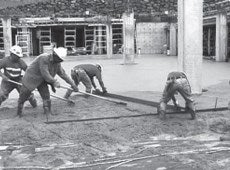The problem
- A hand screed requires the worker to be bent over, using a strong grip to pull the board over the wet concrete.
- Workers exert a lot of shoulder and arm force repeatedly.
- Doing this work often or for a long period of time increases the chance of fatigue and pain.
- It puts major stresses on the back, knees, hands, arms, and shoulders, which may lead to serious muscle or joint injuries.

Hand screeding
One solution
- Use a motorized screed (also called a vibratory screed).
- The worker can work standing upright, and operating the screed takes much less effort than hand screeding.
- This type of screed eliminates both screeding in a stooped position and the need for repeated arm and shoulder movements.

Motorized screeding
How it works
- The motorized screed’s blade or plow floats on concrete.
- The concrete is levelled by a vibrating aluminum screed, which is powered by a gas or battery powered engine.
- It works best for small to medium-sized jobs.
Benefits
- A motorized screed may reduce a worker’s chance of developing muscle and joint injuries.
- This equipment greatly reduces the physical effort needed for hand screeding and eliminates the frequent and prolonged stooping.
- Screeding with motorized equipment can be faster than hand screeding. Many contractors report improvements in productivity.
- The vibration of the blade improves the consolidation of the concrete and reduces time spent “bull floating” the surface.
Potential drawbacks
- Although it can work around electrical or plumbing stubs, some hand screeding may still be necessary.
- It can be difficult to move the screed to and from the work location. A single-engine screed weighs around 50 lbs, and can be awkward to lift and carry. Some screeds have a quick-release system to remove the plow from the frame, which makes carrying easier.
- Vibration can also be a problem.
- It is important to protect workers from hand-arm vibration syndrome (HAVS), a nerve disorder that can become disabling.
- Higher vibration levels are expected when the engine is connected to the frame or shaft that the operator must grip.
- When buying a motorized screed, ask about vibration levels and test drive the screed.
For more information
- For product descriptions related to this solution see the Center for Construction Research and Training (CPWR).
- Products may also be found on the internet using the following search terms: “power screed,” “vibratory screed,” or “concrete screed.”
- Local contractor tool and equipment suppliers or rental companies may be another source of information on products.
- For general information on this solution, call the Infrastructure Health & Safety Association of Ontario at 416-674-2726 or 1-800-781-2726.
This fact sheet is adapted from Motorized concrete screeds Tip Sheet, which we would like to give credit to the following: Albers, James T., and Estill, Cheryl F. (2007) Simple Solutions: Ergonomics for Construction Workers. DHHS, National Institute of Occupational Safety and Health (NIOSH) Publication Number 2007-122.
Construction Solutions is an online product of CPWR – The Center for Construction Research and Training. Research used to develop and maintain Construction Solutions was funded by CPWR, using grant U54 OH008307 from NIOSH. The contents are the sole responsibility of the authors and do not necessarily represent the official views of NIOSH. For more information, visit the CPWR website or CPWR's Construction Solutions website.